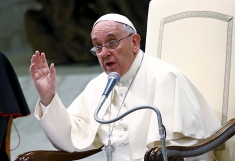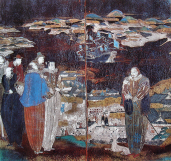
In Oxford's St Giles there is a huge Victorian memorial to the Oxford Martyrs, close to the spot where they were burned at the stake. Today marks 460 years since the deaths of two of them, Nicholas Ridley and Hugh Latimer, in 1555. The third, Thomas Cranmer, was burnt five months later on 21 March 21, 1556.
But who were these men, and why did they die?
They were convicted during the reign of Mary Tudor, known as 'Bloody Mary' for her relentless persecution of Protestants. History has not been kind to her, though she was actually responsible for fewer deaths every year than her father, Henry VIII.
Mary came to the throne in 1553. A committed Roman Catholic, her mother Catherine of Aragon was Henry's first wife; he divorced her to marry Anne Boleyn and had Mary declared illegimitate. Henry was succeeded by his son by Jane Seymour, Edward VI.
Both Henry and Edward tried to get Mary to renounce her Catholicism, without success. When she became queen after overthrowing and beheading Lady Jane Grey, she restored Catholicism and had around 280 Protestants burned at the stake during her five-year reign.
Some of them were ordinary people whose names are not even recorded. The most senior was Cranmer, the Archbishop of Canterbury; Nicholas Ridley was the Bishop of London and Hugh Latimer had been Bishop of Worcester and Edward's chaplain.
The arguments of these times were not just about theology, though theology was very important: both sides believed that they were fighting for the truth, and that teaching wrong doctrine could result in people going to hell. They were also about patriotism. Mary had married King Philip of Spain the previous year, and his position was bitterly resented.
Latimer was 68 years old and frail. He said at his trial for heresy that he did not believe that the bread and wine of communion really became the body and blood of Christ (transsubstantion) or that Christ's sacrifice was repeated at every communion.
According to Foxe's Book of Martyrs, As the flames rose about him, he said to Ridley: "Be of good comfort, Master Ridley, and play the man! We shall this day light such a candle by God's grace, in England, as I trust never shall be put out." However, the words are missing in an earlier edition.
Ridley shared Latimer's Protestantism, but also against him was that he had put his name to letters giving the English throne to the Protestant Lady Jane Grey after Edward's death. He had also said in a sermon that Mary and her sister Elizabeth were illegitimate.
Ridley died more slowly and painfully than Latimer, as the wood was green. Packets of gunpowder were attached to his body but failed to hasten his death, His brother-in-law attempted to speed the process but only succeeded in burning his lower parts more.
Archbishop Cranmer was forced to watch the executions from a tower. He too had come to Protestant views and supported Lady Jane Grey, but after the burnings of Latimer and Ridley he issued several 'recantations' and recognised the Pope as head of the Church. They were not enough to save him from the vengeance of Mary, however, and he was condemned to be burned.
He was allowed to preach a final sermon at the University Church of St Mary in Oxford, with the text submitted in advance. When he reached the end, however, he departed from his script, saying that he renounced his recantations and that he would burn the hand that signed them first. He concluded: "And as for the pope, I refuse him, as Christ's enemy, and Antichrist with all his false doctrine."
An eye-witness account of his death says: "Fire being now put to him, he stretched out his right hand, and thrust it into the flame, and held it there a good space, before the fire came to any other part of his body; where his hand was seen of every man sensibly burning, crying with a loud voice, 'This hand hath offended.' As soon as the fire got up, he was very soon dead, never stirring or crying all the while."
These men are described as "martyrs," but though in many ways they were good men we should not imagine that they were perfect. Latimer helped to bring about the conviction of Catholic martyr John Forest, who was burned at the stake by Henry VIII, and preached the sermon at his execution. Cranmer was involved in the prosecution of John Frith, a Protestant martyr whose views he later came to share; he attempted without success to change Frith's mind and he was burnt in 1533. Ridley was involved in a controversy (the 'Vestments controversy', about what priests and bishops should wear) with John Hooper which saw Hooper imprisoned for a time; Hooper was to become another of Mary's victims.
We can honour their courage without sympathising with their belief that religious truth should be enforced on pain of death.
Lord Byron wrote of this: "Christians have burnt each other, quite persuaded/ That all th' Apostles would have done as they did." It was cruel humour about a cruel time.
















